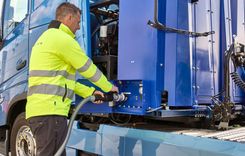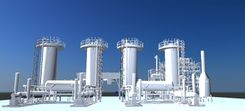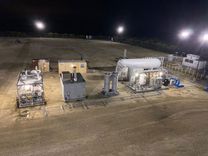Turning Ethanol Into Hydrogen






Volvo, Kenworth and other big name truck manufacturers are building hydrogen versions that can be refueled in roughly the same time as a diesel equivalent version. // Photo: Volvo
June 19, 2023
BY Luke Geiver
Proteum Energy wants to work with ethanol producers to turn ethanol into hydrogen. CEO Laurence Tree tells Ethanol Producer Magazine the company’s path to market—and Proteum’s end goal—seems both plausible and possible. The company has proven tech with more than 35 patents in multiple countries, including Saudi Arabia, the U.S., Canada and India. More than $65 million in investment by a team of engineers working on the process to turn ethanol into hydrogen—for nearly a decade—has gotten results. Researchers from the University of Regina have proven that the Proteum process of transforming natural gas liquids like ethane, or even simply ethanol, can produce a clean, renewable hydrogen. European energy firms are signing up to use it. California will likely be home a Protuem hydrogen production facility in the future. Hydrogen produced from the system, Tree explains, qualifies for the state’s Low Carbon Fuel Standard credits as well as 45Q tax credits. “When ethanol is used as a feedstock with our technology,” Tree says, “the end product’s carbon intensity score can actually be negative.”
And then there is the hydrogen market. Much like the electric vehicle market, the hydrogen sector is an evolving mix of hopeful hype, practical resource opportunities and a technology application that seems to be always on the horizon. The fuel itself is used in a fuel cell and produces water as a byproduct. It can be produced from natural gas, nuclear power, biomass, solar, wind and ethanol. Big names that are widely recognizable on the interstate today are investing in or already using hydrogen as a fuel source; they include Toyota, Volvo Daimler, Kenworth, Cummins, Hyundai and more.
Daimler has already developed a range of prototypes that it has tested in Germany. The company calls hydrogen “a pillar” of its long-term strategy. Cummins, like Daimler, has also invested in prototypes and calls itself a major player in the future of hydrogen-based heavy-duty transportation.
“You see what is going on around the world and there is a clear push to change heavy-duty transportation,” Tree says. “Manufacturers are adopting the technology. They are going to hydrogen because they know it is coming.”
Proteum Energy sees the hydrogen market in the billions. Utilizing its engineering capability and hydrogen production tech, the company intends to enter the market through ethanol, and here’s how it might do it.
The Proteum-Ethanol Connection
Proteum defines itself as a tech company. “We’ve been heads-down on this since 2014,” Tree says. To produce hydrogen, Tree believes Proteum can use existing assets and feedstock. “There are some extraordinary assets in the ethanol sector,” he says, explaining how impressed his team has become with the ability of ethanol producers and their leading role in carbon capture, utilization and/or sequestration (CCUS).
The approach by Proteum is to partner with ethanol producers or buy ethanol gallons directly from them. There are two main business models. The Partner-Customer Tolling model locates a modular system at a partner’s facility. Proteum works with partners to resource feedstock and CO2 sequestration. Proteum would receive a tolling fee and may use excess hydrogen production capacity to produce hydrogen or other designer fuels for third-party customers. Alternatively, in the Build-Own-Operate model, the company would install its system at a location of favorably priced feedstock and CO2 sequestration/utilization. Proteum would source and purchase feedstock, process H2 fuel, along with other designer fuels. CO2 produced during hydrogen production would be sold or sent to permanent storage, potentially generating tax incentives. Lastly, hydrogen fuel or designer options would be sold to customers.
Advertisement
Advertisement
The technology module is built off a system that relies on high-temperature thermals that create steam before converting that steam to hydrogen. Steam-methane reforming, the main method used today for producing hydrogen, typically relies on natural gas liquids—mainly methane—as a feedstock. Methane in the presence of steam at 3 to 25 bar pressure (1 bar equals 14.5 psi), along with a catalyst, produce hydrogen, carbon monoxide and a small amount of CO2. They call it the water-gas-shift reaction, according to the U.S. Department of Energy. In the final step of the reformation process, carbon dioxide and other impurities are removed from the stream, leaving pure hydrogen.
Feedstock gas for Proteum (in this case an ethanol beer cut) and low amounts of water are fed into the core technology platform where it first runs through standard auxiliary equipment before entering the proprietary steam non-methane reformer technology. The result is clean hydrogen fuel. Additional modular units can be added for CO2 separation, H2 separation, or synthetic natural gas.
If ethanol is used as the feedstock, it must be injected at 375 to 500 psig and be oxygenated. The base systems produce 19,000 kg/day. For utilities, the electrical needs are 480V three-phase wye, 60 Hz, less than 1.0 MVA. The water source amount can be a dilute-alcohol feed (e.g. 40 vol% ethanol) or fresh water at a rate of 10 gallons per minute. A 10 MB minimum connection is also required. The overall footprint of the base modular unit is roughly half an acre and they can be integrated with waste heat recovery systems.
According to Tree, the Proteum business model relies on four things: feedstock, a hydrogen offtaker, a CCS project and land. With an ethanol partner providing the feedstock through a joint venture or through sale, Proteum already has offtakers ready for the hydrogen product. Working with an ethanol producer that is sequestering carbon, Proteum can send over roughly 500 tons of CO2 per day.
“We can also provide the ethanol producer with some waste heat and power to their facility,” he says.
More Than a Goal
Proteum is currently working on the buildout of a hydrogen production facility in California, according to Tree. But the team is also working to expand across the Midwest ethanol belt. Starting in 2014, the company had already racked up several important milestones. It all started as a technology proof of concept to better utilize flare gas produced during shale oil and gas production. A system was tested in the Bakken of North Dakota, along with shale plays in Texas. A commercial system was deployed in 2017, used by major exploration and production company Diamondback Energy in 2018 to help utilize flare gas; it received a statement of endorsement and technical qualification by global consulting and testing firm DNV GL in 2020; tested and proven for hydrogen production from NGLs in 2021; and turned fully commercial through term sheets in 2022.
Advertisement
Advertisement
Late last year, the company signed with Transitus Energy to produce hydrogen from hydrocarbons produced in the North Sea. The agreement included a letter of intent for opportunities in the U.K., Netherlands, Republic of Ireland and Norway to produce low-carbon hydrogen for European markets.
Now, Tree jokes that ethanol producers can get into the diesel business by producing clean hydrogen that could or will replace fossil-based diesel. He knows some aren’t sold on hydrogen or the idea of a new fuel type. But he also is quick to rattle off story after story of major trucking companies announcing moves into hydrogen fleet expansions. Or stories from California about diesel trucks being removed from the roads by 2035. And, to help illustrate the difference between electric heavy cargo trucks and hydrogen fueled alternatives, he points to weight and time. EVs are much heavier, and they also require much more time to recharge. A refill on a hydrogen-fueled truck takes about the same time as a fossil-based diesel option, he says, and that alone is attractive to OEMs looking at investing in hydrogen.
Proteum isn’t alone in its quest to turn ethanol into clean hydrogen. Just last year, Shell signed a deal with two Brazil ethanol plants to produce hydrogen.
In addition to hydrogen fuel for over-the-road transportation, the modular units created by Proteum can produce hydrogen for sustainable aviation fuel or for low-carbon ammonia fertilizer products, as well.
And then there is the variable that the entire ethanol industry is following: carbon intensity score. The best-case scenario for inputs used to create the hydrogen would net a negative CI score. With biogas combustion fuel or waste heat recovery in the mix, Proteum’s liquid H2 can have a CI score of 8.7 g/MJ.
Tree and his team can serve several markets, utilize a variety of feedstocks and produce a variety of highly-desirable, incentivized end-products. But it's the ethanol sector they are trying to align with, he says. It is a new place to send ethanol gallons, his team believes, and it is a continuation of ethanol’s momentum leading carbon offset efforts or the decarbonization of transportation molecules. It’s not an entire hydrogen revolution or move away from one type of production method or use of feedstock. It is something different, sort of a gain by doing more with an existing asset (tech and ethanol). “We like to call it an energy addition.”
Author: Luke Geiver
Contact: editor@bbiinternational.com
Printed in the July 2023 issue of Ethanol Producer Magazine
Related Stories
The U.S. Energy Information Administration maintained its forecast for 2025 and 2026 biodiesel, renewable diesel and sustainable aviation fuel (SAF) production in its latest Short-Term Energy Outlook, released July 8.
XCF Global Inc. on July 10 shared its strategic plan to invest close to $1 billion in developing a network of SAF production facilities, expanding its U.S. footprint, and advancing its international growth strategy.
U.S. fuel ethanol capacity fell slightly in April, while biodiesel and renewable diesel capacity held steady, according to data released by the U.S. EIA on June 30. Feedstock consumption was down when compared to the previous month.
XCF Global Inc. on July 8 provided a production update on its flagship New Rise Reno facility, underscoring that the plant has successfully produced SAF, renewable diesel, and renewable naphtha during its initial ramp-up.
The USDA’s Risk Management Agency is implementing multiple changes to the Camelina pilot insurance program for the 2026 and succeeding crop years. The changes will expand coverage options and provide greater flexibility for producers.
Upcoming Events










